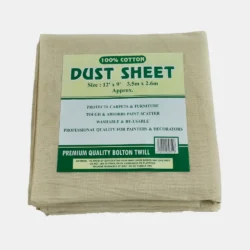-
Heavy Duty Cotton Dust Sheets
Heavy Duty Cotton Dust Sheets – 12’x9′
£11.96 – £810.63 Select options This product has multiple variants. The options may be chosen on the product page
The Ultimate Guide to Using Cloth Dust Sheets: Keep Your Home (and Sanity) Intact
Ah, DIY projects. A chance to unleash your inner creative genius and personalize your space. But let’s be honest, the looming threat of dust and debris can quickly dampen that enthusiasm. Here’s where the humble cloth dust sheet emerges as your superhero.
This unassuming fabric warrior shields your furniture, floors, and belongings from the inevitable fallout of renovation and decorating projects. But using cloth dust sheets effectively is an art form, and this guide equips you with the knowledge to become a master protector.
Unveiling the Cloth Dust Sheet: Types and Their Uses
Not all cloth dust sheets are created equal. Here’s a breakdown of the most common types and their ideal applications:
Cotton twill dust sheets: These are your classic warriors, known for their breathability and reusability. Their woven cotton construction makes them perfect for catching dust and debris during painting, decorating, or light DIY projects.
Polycotton laminated dust sheets: For projects involving spills or splashes, consider laminated dust sheets. These combine the dust-catching prowess of cotton twill with a waterproof polythene backing, offering ultimate protection from liquids.
Drop cloths: These heavyweight cotton canvases are ideal for heavy-duty projects that generate a lot of debris. Think sanding floors, removing wallpaper, or tackling major renovations.
Non-slip dust sheets: These innovative dust sheets feature a textured underside that prevents them from slipping on smooth surfaces. This is a game-changer for areas with high foot traffic, ensuring safety and minimizing frustration.
Prepping for Battle: Preparing Your Dust Sheet
Before deploying your cloth dust sheet, take some time for prep work. Here’s how to optimize its effectiveness:
Size matters: Choose a dust sheet large enough to completely cover the area you’re protecting. Overlap it slightly on walls or baseboards for extra protection. Don’t be afraid to layer smaller dust sheets for larger areas.
Give it a shake: A quick shake outdoors removes any pre-existing dust or debris that might transfer to your clean surfaces.
Secure the fort: Don’t let your dust sheet become a hazard. Use painter’s tape or masking tape to secure the edges to walls or baseboards. This prevents wind or accidental bumps from dislodging the sheet. For furniture, tuck the edges under or use furniture covers for added security.
Dust Sheet Deployment Strategies: Different Areas, Different Approaches
Now that your dust sheet is prepped and ready, let’s explore how to tackle specific areas:
Furniture: For large furniture pieces like sofas or armchairs, drape the dust sheet over them entirely. For smaller items like tables or chairs, cover the top surface and secure the sheet around the legs.
Floors: Unfold the dust sheet carefully to avoid spreading dust. If using multiple sheets, ensure they overlap generously to create a seamless barrier. For carpeted areas, consider using a double layer of dust sheet for extra protection.
Electronics and appliances: Unplug electronics before covering them. For delicate appliances like TVs or computers, use dust covers specifically designed for them.
Doors and doorways: Protect doorways by hanging a dust sheet secured with masking tape on the frame. This creates a dust barrier without obstructing entry or exit.
Maintaining Your Dust Sheet Fortress: Cleaning and Storage
Shake it off: After use, give the dust sheet a good shake outdoors to remove any accumulated dust or debris.
Washing woes: Check the care instructions on your dust sheet. Most cotton twill sheets can be hand-washed or machine-washed on a gentle cycle with mild detergent. Avoid using harsh chemicals or bleach, which can damage the fabric.
Drying matters: Allow the dust sheet to dry completely before storing it. Dampness can lead to mildew growth. Hang it outside on a clothesline or lay it flat on a clean surface for air drying.
Storage solutions: Fold your dust sheet neatly and store it in a cool, dry place away from direct sunlight. A plastic storage bin or a cloth bag protects it from dust and moisture.
Beyond the Basics: Pro Tips for Using Cloth Dust Sheets
Here are some additional pointers for maximizing your dust sheet mastery:
Double duty: Dust sheets aren’t just for DIY projects. Use them as drop cloths for messy art projects, as a ground cover for gardening activities, or even as a temporary picnic blanket.
Labelling magic: If you have multiple dust sheets, label them according to size or intended use. This saves time and frustration when searching for the right sheet for the job.
DIY dust sheet repair: Small tears or rips in your dust sheet can be easily mended with a needle and thread. For larger holes, consider using fabric patches for a sturdier fix.
Creative dust sheet uses: Get crafty with your dust sheets! Cut them into smaller pieces to create dust covers for specific items like lamps or sculptures. You can even use them as drop cloths for messy kitchen tasks like cleaning appliances or prepping food.
Breathe Easy: The Advantages of Using Cloth Dust Sheets
Here’s a quick recap of why cloth dust sheets reign supreme:
Eco-friendly: Unlike disposable plastic sheeting, cloth dust sheets are reusable and reduce environmental impact.
Breathable: Cotton twill dust sheets allow air to circulate, preventing moisture build-up and potential mould growth.
Cost-effective: A high-quality cloth dust sheet is a long-term investment, saving you money compared to constantly buying disposable alternatives.
Versatility: Cloth dust sheets have numerous applications beyond DIY projects, making them a multipurpose tool in your home.
Durability: When properly cared for, cloth dust sheets are built to last, withstanding wear and tear from multiple projects.
Conclusion: Embrace the Power of the Cloth Dust Sheet
By incorporating these tips and strategies, you can transform the humble cloth dust sheet into a powerful ally in your DIY endeavours. Remember, a little preparation and the right tools can make all the difference in keeping your home (and your sanity) intact during any project. So, the next time you embark on a DIY adventure, grab your trusty cloth dust sheet and conquer those renovations with confidence!




